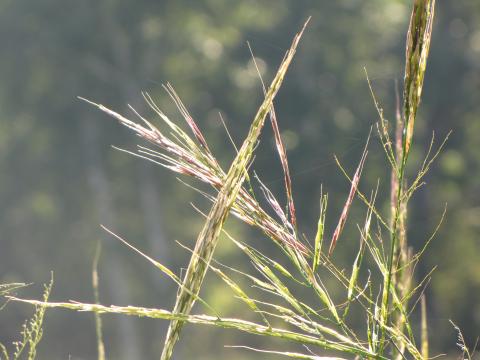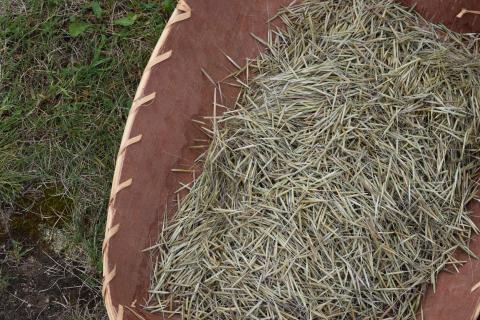Ganawenindiwag Manoomin Anishinaabeg means "The Rice and the People take care of each other" and encapsulates the primary goal of the Manoomin program: to increase the health of the human and manoomin relationship, so that the generations yet to come will always know and be able to give thanks for the generosity of Manoomin.
Manoomin translates into "The Good Berry" in Ojibwe, and plays a major role in the lives of Ojibwe people. According to Ojibwe prophecy, centuries ago the Ojibwe were instructed to find the place where "the food grows on water" during their long migration from the East coast. This ultimately led them to the Great Lakes region and the northern inland lakes of Michigan, Wisconsin, and Minnesota where flowing beds of Manoomin were found in abundance.
When the Anishinaabeg came to the region, the Manoomin and the People built a long-standing relationship in which they took care of each other. When finished traditionally, the grain could be stored for long periods of time and provided healthy food when other sources were not available. Besides being fundamental to the traditional diet, Manoomin is also important culturally and spiritually and remains a vital component in many feasts and ceremonies today.
Through the knowledge of tribal rice chiefs, elders, and member tribes' Natural Resource Departments, GLIFWC has built capacity to educate about the health and importance of Manoomin. While our most fundamental knowledge about the rice comes from traditional observations and ecological knowledge (TEK), GLIFWC's Manoomin program utilizes research to find pieces in the puzzle of its decline in order to assist with decision making.
In GLIFWC's Climate Change Team's 2023 publication, Aanji-bimaadiziimagak o’ow aki: Climate Change Vulnerability Assessment Version 2, Manoomin was found to be the most vulnerable plant to dangers such as climate change, which drives more frequent, severe storm events and mild winters, as well as past and present mining operations and other sources that pollute the waters.
Habitat Requirements of Manoomin
Water Flow: Rice requires the presence of flowing water, with rivers, flowages, and lakes that have an inlet and outlet being optimal examples. Springs on some lakes may even provide the inflow necessary for growth. In lakes with relatively low flow, rice may persist but will typically vary more in abundance from year-to-year. Manoomin generally does not persist on land-locked waters perhaps due to the lack of nutrient inputs that flow provides.

Water Depth: Rice grows in about 6 inches to 3 feet of water, with the middle of this range being optimal. Plants found growing in deeper water at the edge of beds provide protection to the bed behind by absorbing and dampening wind and waves.
Water Clarity/Color: Clear water is preferred, as very dark or turbid water limits sunlight penetration and may hinder germination and early plant development. Rice beds can be supported on moderately stained waters, particularly where water depths are limited to 2 feet or less.
Water Fluctuations: Generally annual fluctuations should not be too great during the growing season. Water levels that are relatively stable or decline gradually during the season are most favorable. However, too much stability in water levels over many years may be detrimental and may lead to perennial plants outcompeting Manoomin. Some natural fluctuations should be maintained, even if it means an occasional poor year for rice.
Sediment Type: Several inches of soft organic muck is considered optimal. However, rice is fairly tolerant and beds can be found on a wide variety of bottom types including sandy and semi-rocky substrates when other growing conditions are good.
Pollution: Rice can be particularly vulnerable to water pollutants, including sulfates, which enter the water through waste and industrial discharge. Metal mining and other sources of pollution have been linked with impaired and collapsed rice beds.
Traditional methods used by the Ojibwe people to harvest Manoomin are still used today. The same is true for finishing the harvested rice, although some have mechanized aspects of finishing. Green, or freshly harvested rice, must be processed or finished before it is pantry ready. Finishing steps include: drying, parching, hulling, and winnowing. A typical yield from fresh green rice to finished is about 35-45%, so that 50 pound sack of manoomin you left the lake with might put 20 pounds of finished rice on your pantry shelf.
Drying: Freshly harvested rice must be dried as soon as it comes off the lake to prevent molding. The first step involves spreading the manoomin out on plastic tarps or birch bark mats allowing it to air dry in the sun. Unwanted plant segments and insects are removed during this step.
Parching: Additional moisture is removed through the parching, or roasting, process. Parching is often accomplished by transferring Manoomin from the drying tarp to a cast iron kettle set on a small fire. The rice must be stirred continuously to prevent grains from overheating and "popping". Parching serves three primary functions: it destroys the germ so it cannot re-sprout; it dries and loosens the sheath which surrounds the grain; it reduces moisture content in the seed allowing the manoomin to be preserved in an edible state for years when stored in a dry environment.

Hulling: Hulling separates the sheath from the rice seed. Traditionally a shallow pit is dug and lined with wood, an animal hide, or a tarp. After parched rice is placed in the pit, it is "danced on." Using special moccasins the huller treads on the grain, rolling it against their feet. Most of today's finishing is done mechanically.
Winnowing: All that remains is to separate the grain from the chaff. Hulled rice is transferred to a basket held two-handed by a winnower. With a vertical snap of the wrist, light chaff is propelled away while the heavier manoomin kernals return to the basket. The winnower repeats this process until all the chaff has been removed. Thorough finishers then hand pick through the rice to remove the hulls from any grains where they still remain. The rice is now ready to be cooked or stored for the months ahead.
Bill Burns
73016 Maple Street
Odanah, WI 54861
(715) 292-7060
Wayne Dupuis
1025 Mission Road
Cloquet, MN 55720
(218) 310-7588
Jeff Savage
1780 Blue Spruce Drive
Cloquet, MN 55720
(218) 879-0157
Spirit Lake Native Products
Bruce & Tawny Savage
1032 Spirit Lake Road
Sawyer, MN 55780
(218) 393-6902
spiritlakesugar@gmail.com
Bickering Canoe Wild Rice Processing
Odanah, WI 54861
Maria - (715) 685-4802
J.D. - (715) 209-1430